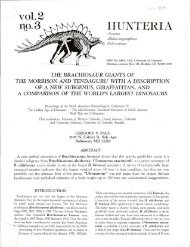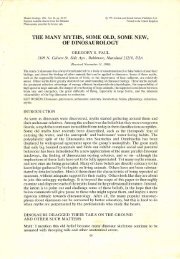Dinosaur models: the good, the bad, and using - Gregory S. Paul
Dinosaur models: the good, the bad, and using - Gregory S. Paul
Dinosaur models: the good, the bad, and using - Gregory S. Paul
Create successful ePaper yourself
Turn your PDF publications into a flip-book with our unique Google optimized e-Paper software.
Dinofes~ International Proceedings 137<br />
FIGURE5-Shoulder blades <strong>and</strong> aft dorsal vertebrae of sauropods, to same scale, scale bar equals 1 m. From left to right, Supersaurus ~50 tonnes,<br />
Apatosaurus 18 t blade <strong>and</strong> vertebra, Amphicoelias altus ~ 12 t, Amphiccelias [ragillimus ~ 125 t, Argentinosaurus ~90 t. Black parts are preserved.<br />
been an astonishing 2.4 to 2.7 m tall, taller than a human <strong>and</strong><br />
around twice that of <strong>the</strong> typical diplodocids (including Seismosaurusi.<br />
Even prudent calculations imply a super-sauropod 40<br />
m long <strong>and</strong> weighing 100 tonnes, figures of 60 m (equal to a<br />
blue <strong>and</strong> sperm whale combined) <strong>and</strong> 150 tonnes are equally<br />
plausible. These figures outclass even Late Cretaceous titanosaurs,<br />
whose limbs were heavily loaded by <strong>the</strong>ir very broad<br />
abdomens. The enormous dorsals (Figure 5) of Argeruinosaurus<br />
(Bonaparte <strong>and</strong> Coria, 1993), although much shallower than<br />
those of Amphicoelias at about 1.5 m, were twice as long as<br />
those of Apatosaurus, Seismosaurus, <strong>and</strong> Brachiosaurus, <strong>and</strong> indicate<br />
that <strong>the</strong> dorso-sacral column was very long (about 7 m),<br />
even relative to <strong>the</strong> very long (1.6 m) fibula that was as long as<br />
<strong>the</strong> femur of some lesser sauropods. Using dorsal series/mass<br />
relationships of o<strong>the</strong>r broad bellied sauropods as a guide, <strong>the</strong><br />
mass of Argentinosaurus is estimated at 80-100 tonnes. Some<br />
extremely long titanosaur femurs may represent animals of similar<br />
bulk (if so <strong>the</strong>y are more massive than calculated by <strong>Paul</strong><br />
[1988a]). Anderson et al. (1985) suggested that two thick shafted<br />
titanosaur femora represent exceptionally heavy individuals, but<br />
<strong>the</strong> o<strong>the</strong>r dimensions of <strong>the</strong> bones do not support this conclusion.<br />
In any case, titanosaurs demonstrate that sauropods did not experience<br />
a size decrease in <strong>the</strong> Cretaceous. Note that <strong>the</strong> downwards<br />
revision of sauropod masses in general limits <strong>the</strong> estimated<br />
masses of <strong>the</strong> largest fragmentary specimens. On <strong>the</strong> o<strong>the</strong>r<br />
h<strong>and</strong>, it is very unlikely that <strong>the</strong> largest sauropods have been<br />
.discovered. Aside from <strong>the</strong> <strong>good</strong> possibility that one or more<br />
even more gigantic species remain unknown, occasional "world<br />
record" sauropods may have approached 200 tonnes, <strong>the</strong> mass<br />
of large blue whales (Mcf-arlan <strong>and</strong> McWhirter, 1989).<br />
Armored <strong>Dinosaur</strong>s, <strong>and</strong> <strong>the</strong> Moving Coffee Tables<br />
Stegosaurs <strong>and</strong> ankylosaurs had small or modest sized skulls<br />
<strong>and</strong> necks that contributed little to <strong>the</strong>ir mass. The moderate<br />
sized tails were well muscled at <strong>the</strong> base, much less so distally.<br />
Hyper-elongated forward processes of <strong>the</strong> pelvic ilium bone<br />
probably helped support <strong>the</strong> gut, <strong>and</strong> any leg muscles anchored<br />
at <strong>the</strong> front end were probably thin. The assorted armor plates<br />
<strong>and</strong> spines were porous boned, often thin <strong>and</strong>/or hollow centered,<br />
<strong>and</strong> contributed little weight (so armored dinosaurs could<br />
probably float as well as armored crocodilians, l<strong>and</strong> turtles, <strong>and</strong><br />
armadillos).<br />
Most stegosaurs have broad hips that supported similarly<br />
broad abdomens. The exception was narrower hipped Stegosaurus,<br />
but <strong>the</strong> slab sided gut was still capacious because it was<br />
deep. Large stegosaurs had moderate sized, elephantine nonrunning<br />
limbs. The mass of <strong>the</strong> biggest stegosaurs was comparable<br />
to Asian elephants <strong>and</strong> female African elephants.<br />
The trunk vertebrae of ankylosaursare long <strong>and</strong> numerous,<br />
so <strong>the</strong> trunk is long (as per Coombs, 1979; <strong>Paul</strong>, 1995). Some<br />
restorations have been too short-trunked, <strong>and</strong> this has forced <strong>the</strong><br />
artist to naITOW<strong>the</strong> hips (Carpenter, 1984). Ankylosaurs actually<br />
had almost unbelievably broad abdomens <strong>and</strong> bellies. Complete<br />
<strong>and</strong> little crushed hips consistently show that <strong>the</strong> front ends of<br />
<strong>the</strong> ilia flare far out to <strong>the</strong> sides <strong>and</strong> are supported by very long<br />
hip ribs. Undistorted abdominal ribs are also extraordinary for<br />
<strong>the</strong>ir strong sideways arc which made <strong>the</strong>m as broad as <strong>the</strong> hips.<br />
The increase in body breadth from <strong>the</strong> naITOWchest to <strong>the</strong> fat<br />
belly is so fast <strong>and</strong> extreme that <strong>the</strong> blade of <strong>the</strong> scapula is<br />
strongly twisted along its length in order to accommodate <strong>the</strong><br />
strong helical curve of <strong>the</strong> top of <strong>the</strong> front part of <strong>the</strong> ribcage.









